Top 10 Blockchain Platforms to Build Smart Contracts in 2025
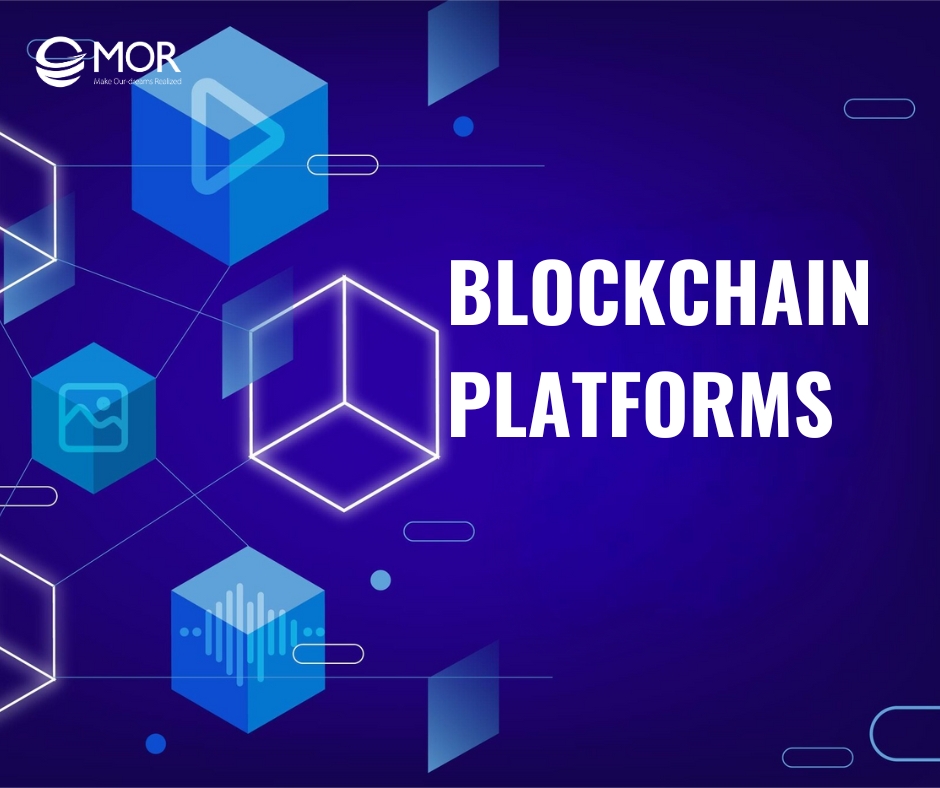
Choosing the right blockchain platforms to build smart contracts isn’t just a tech decision. It can shape the future of your entire business. With so many options on the market, how do you know which one fits your needs, budget, and goals? This guide from MOR Software breaks down the top 10 blockchain platforms for 2025 and helps you understand which one is worth your investment.
What Are Blockchain Platforms?
Before diving into smart contract development, it helps to understand what blockchain platforms actually do.
A blockchain platform is the underlying system that supports decentralized apps and smart contracts. It works through a network of nodes that validate transactions and store them in blocks. These blocks are secured using cryptographic methods, making the data permanent and tamper-proof.
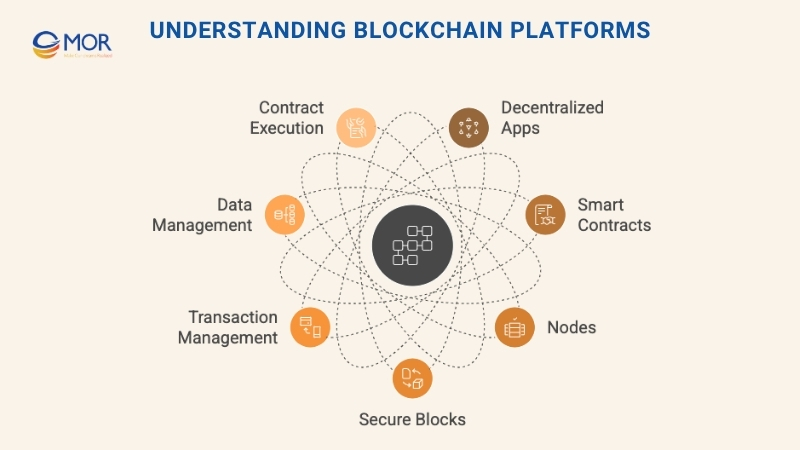
Gartner projects that blockchain will add more than US$3.1 trillion in business value by 2030. This shows how central these platforms are becoming to enterprise strategy.
Smart contracts run directly on these platforms. Once conditions are met, they execute automatically, no middlemen needed.
Behind the scenes, smart contract platforms handle transaction approval, data management, and contract execution. They give developers everything they need to build secure, self-running agreements that can't be altered after deployment.
Benefits Of Blockchain Platforms For Businesses
Why are blockchain platforms gaining traction across industries? It comes down to a mix of security, transparency, and automation that traditional systems can’t match.
- Built-in Security: Every transaction is protected using cryptographic methods, making tampering nearly impossible.
- Shared Transparency: All parties can view approved transactions, helping build trust and accountability. A Deloitte–MIT study found that 70% of executives expect smart contracts to complement, rather than replace, traditional legal agreements, mainly because the transparent ledger lets parties verify terms in real time.
- Decentralized Structure: There’s no central point of control or failure, which improves system reliability.
- Permanent Records: Once something’s recorded, it stays there. No edits, no cover-ups.
- Self-Running Contracts: With smart contracts, tasks run automatically based on conditions, no manual oversight required.
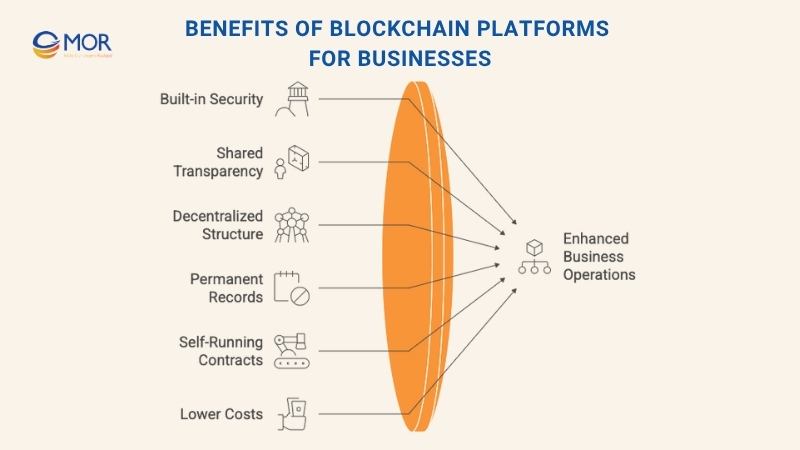
- Lower Costs: Fewer middlemen means faster transactions and fewer fees. The Bank for International Settlements estimates that blockchain-based cross-border payments can cut transaction costs by up to 95% compared with traditional correspondent banking.
- Borderless Access: Anyone with internet access can connect to a public blockchain platform from anywhere in the world.
- Reliable Data: Businesses can trace and verify information at every step, which is key in supply chain and logistics.
- Room to Innovate: From banking to healthcare, industries are using these tools to solve long-standing problems. Grand View Research forecasts the global blockchain market will reach roughly US$1.43 trillion by 2030, growing at a compound annual rate above 90%.
- Digital Asset Creation: These platforms support tokenization, opening up new models for funding and ownership.
Top 10 Blockchain Platforms For Business Use In 2025
The market is crowded, but not every blockchain platform is built for smart contract execution or real-world business use. We’ve narrowed it down to the ten that matter most in 2025.
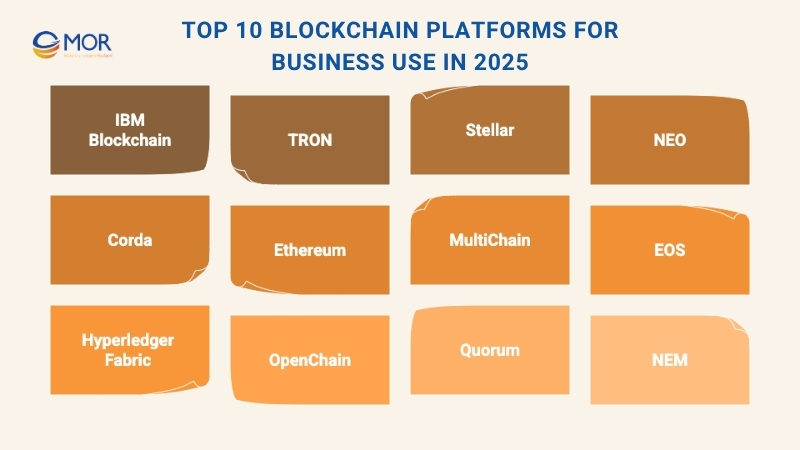
IBM Blockchain
IBM offers one of the most business-ready solutions in the blockchain platforms space. Built on Hyperledger Fabric, it gives companies a modular, cloud-compatible infrastructure to launch and grow private blockchain networks.
The platform is fully managed and lets users run their networks in the environment of their choice. From supply chain verification to secure data exchange, IBM Blockchain supports complex enterprise use cases. It’s also designed to work smoothly with other cloud tools, whether you’re integrating storage, APIs, or external services.
Key Features
Feature | Description |
Enterprise-Level Foundation | Based on Kubernetes, using Hyperledger Fabric with flexible deployment. |
Developer-Friendly Tools | Provides intuitive tools for creating and managing smart contracts. |
Granular Control | Users can fine-tune network settings and scale as needed. |
Trusted Workflows | Designed for automating and optimizing business processes across parties. |
Smart Contract Support | Enables product verification and asset digitization. |
Immutable Ledger | Tamper-proof recordkeeping that all members can access. |
Asset Tracking | Helps manage and transfer value securely with full transparency. |
TRON
TRON functions as a decentralized operating system where developers can build applications and share content directly with users, no middlemen required. Its native token, TRX, is used to interact with platform features and reward content creators for their contributions.
Originally designed to improve compensation for creators, TRON allows them to earn crypto directly from users. Thanks to its high-speed performance and Ethereum compatibility, it’s often chosen by smart contract developers who need a low-cost, high-throughput platform.
Key Features
Feature | Description |
Content-First Blockchain | Built for media distribution, using TRX as its native currency. |
Direct Monetization | Removes intermediaries between creators and their audiences. |
Smart Contract Support | Developers can write TRX-based contracts using Solidity. |
Zero-Fee Transactions | Operates using internal credits (Bandwidth and Energy). |
Speed at Scale | Handles up to 2,000 transactions per second. |
Delegate System | Relies on user-voted representatives to validate transactions. |
Cross-Chain Compatibility | Easily migrates Ethereum projects to the TRON network. |
Stellar
Stellar is a blockchain development platform known for cross-border payments and low-cost financial transfers. It allows users to send and exchange digital versions of any currency, dollars, euros, crypto, and more, within seconds.
Unlike traditional companies, Stellar is supported by a nonprofit organization focused on global financial access. It offers tools for fintech firms to build fast, cost-effective solutions without giving up transparency or security.
Key Features
Feature | Description |
Public and Permissionless | Open-source and decentralized, built for international reach. |
Instant Settlement | Confirms transactions in 3–5 seconds, even across borders. |
Value Exchange Engine | Supports diverse currency types and seamless transfers. |
Built-In DEX | Allows direct token swaps without third parties. |
Contract Flexibility | Enables smart contracts and multi-signature setups. |
Minimal Transaction Fees | Costs a fraction of a cent per operation. |
Developer Tools | Provides SDKs and APIs to speed up app development. |
NEO
NEO, once called Antshares, rebranded in 2017 with a clear purpose: to build a smarter, digitally connected economy using blockchain platforms and programmable contracts. The goal? Automate the management of digital assets through secure, efficient smart contract execution.
NEO delivers a full-feature development environment straight out of the box. Developers can build decentralized applications without needing to piece together external tools. One of its standout advantages is built-in interoperability, giving projects access to multiple blockchain networks with ease.
In 2021, NEO launched its N3 upgrade, a major leap forward that introduced faster consensus, native storage, oracles, and multi-language contract support, delivering a complete project blockchain toolkit for serious builders.
Key Features
Feature | Description |
Instant Finality | Consensus using dBFT ensures one-block confirmation. |
Oracle Integration | Connects contracts to external data safely. |
NeoFS | Distributed cloud storage focused on privacy and speed. |
Multi-Language Contracts | Supports C#, Go, Python, Java, and TypeScript. |
Naming System | Uses .neo domains for decentralized app identity. |
Interoperability | Links to Ethereum, Binance Chain, and others via Poly.Network. |
NeoID | Offers decentralized identity standards for compliance-based apps. |
Corda
Corda was built from the ground up with enterprise in mind. It allows businesses to transact directly and in strict privacy, using a shared ledger that doesn’t broadcast data to every participant. That makes it ideal for sectors where confidentiality is non-negotiable, like healthcare, construction, and finance.
Rather than operating like public blockchain platforms, Corda uses smart contract logic to manage valid state transitions between parties. It also offers timestamping services and notary nodes to resolve disputes and track sequencing without a central controller.
Corda makes integration simple, using familiar standards like REST APIs and X.509 certificates. It’s one of the most practical blockchain solutions for companies that need both speed and compliance.
Key Features
Feature | Description |
Contract Execution Logic | Manages how states change based on contract rules. |
Time and Uniqueness Service | Coordinates transaction order through notary pools. |
Flow Framework | Supports complex, multi-step workflows between companies. |
Selective Privacy | Shares data only with involved parties. |
Inter-Network Value Transfer | Transfers assets across Corda networks securely. |
Regulatory Readiness | Built to align with standards like ISO 20022. |
Enterprise Integration | Works with common enterprise tech stacks. |
No Central Authority | Enables peer-to-peer interaction without needing central oversight. |
Ethereum
Ethereum is one of the most widely used blockchain platforms, serving as the foundation for decentralized finance, digital assets, and Web3 innovation. Its open-source model encourages collaboration from developers across the globe, leading to a steady evolution of tools, protocols, and governance models.
The platform introduced the world to smart contracts and decentralized applications (DApps), which now support everything from gaming to banking. Ethereum also supports decentralized autonomous organizations (DAOs), letting communities govern projects without centralized leadership.
A major milestone came with Ethereum’s shift from proof-of-work to proof-of-stake. This upgrade, often referred to as "Ethereum 2.0," drastically improved scalability, reduced energy usage, and opened the door for more efficient transaction handling across the crypto network.
Key Features
Feature | Description |
ETH Token | Used for transactions, gas fees, and smart contract execution. |
Smart Contracts | Allows trustless, automated operations. |
EVM (Ethereum Virtual Machine) | Executes all smart contract logic on the chain. |
DApps | Enables decentralized services and apps. |
DAO Support | Powers governance models without central control. |
Cryptographic Security | Ensures all transaction records are immutable. |
Verified Transactions | Every operation is digitally signed and traceable. |
Asset Exchange | Allows secure multi-asset trading across users and apps. |
MultiChain
MultiChain is an open-source framework that extends the capabilities of Bitcoin to suit business needs. It lets users launch tailored blockchains, either private or public, with minimal setup. Designed with enterprise AI platforms use in mind, it includes tools for managing permissions, issuing tokens, and storing complex datasets securely on-chain.
You can configure your chain before deployment through a simple settings file. Once live, MultiChain ensures stable operations with strict rules on consensus and access control. It’s one of the few blockchain platforms that offers this level of low-code customization for businesses.
Key Features
Feature | Description |
Fast Setup | Deploy new chains and applications with ease. |
Asset Management | Issue and track millions of tokens or digital assets. |
On-Chain Databases | Store key-value pairs, time-series data, and identities. |
Access Control | Set detailed permissions for transactions and operations. |
Developer-Oriented | Simple for coders to build and test applications. |
Custom Blockchain Settings | Configure your network behavior pre-launch. |
Security Options | Supports multi-signatures, cold wallets, and role-based access. |
Private Network Mode | Ideal for confidential business operations. |
Chain-to-Chain Communication | Allows different MultiChain instances to talk. |
Storage Efficiency | Data streams double as general-purpose storage. |
EOS
EOS is a performance-focused blockchain platform that offers a powerful environment for building secure and scalable applications. It gives developers access to decentralized storage, fast execution, and a flexible smart contract system, all in one place.
What sets EOS apart is its support for parallel processing and permission customization, which allows apps to scale without compromising on security. Unlike older chains, it also supports upgrades without requiring forks, making it easier to evolve as projects grow.
Key Features
Feature | Description |
Smart Contract Upgrades | Change contract logic without replacing the entire app. |
Role-Based Access | Fine-tuned user permissions for added control. |
Fork-Free Updates | Upgrade capabilities without network splits. |
App Development Platform | Build and deploy apps using EOS tokens. |
Parallel Transactions | Run multiple operations at once for better performance. |
Secure Identity and Access | Tools for safe DApp access and data protection. |
Full-Stack Support | EOS.IO manages scaling across vertical and horizontal dimensions. |
Hyperledger Fabric
Hyperledger Fabric is a modular, enterprise-grade blockchain based ecommerce platform built by the Linux Foundation. It enables businesses to build secure applications with strict control over user identity, data privacy, and consensus rules.
Its standout feature is a permissioned setup, only authorized participants can access the network, making it ideal for sensitive industries. The plug-and-play architecture lets companies choose from different components based on project needs.
Hyperledger Fabric is widely adopted in supply chain, finance, and manufacturing where multi-party collaboration and traceability are critical.
Key Features
Feature | Description |
Modular Design | Choose components like consensus and membership services. |
Configurable Consensus | Swap in different consensus models based on use case. |
Private Network Setup | Access restricted to approved participants only. |
Flexible Contract Models | Supports custom business logic in multiple languages. |
Isolated Channels | Create private data partitions for different groups. |
MSP Integration | Uses Membership Service Providers for user validation. |
Smart Contract Compatibility | Chaincode supports Go, Java, and other languages. |
OpenChain
OpenChain is a lightweight, open-source ledger system built to help businesses manage digital assets with speed and simplicity.
Rather than relying on miners or heavy consensus layers, OpenChain uses a partitioned consensus model where a single administrator verifies transactions on each instance. This approach eliminates congestion and enables fast, direct execution.
Its client-server structure allows faster processing and scalability while keeping costs low, there are no mining fees, making it ideal for internal operations or trusted networks. As one of the more accessible blockchain platforms, it’s often used by enterprises needing controlled environments with real-time verification.
Key Features
Feature | Description |
Distributed Ledger Tech | Fully open-source with decentralized recordkeeping. |
Instant Finality | Transactions confirm immediately without mining delays. |
Zero Fees | No transaction costs due to miner-free architecture. |
Quick Setup | Easy to configure and deploy in business environments. |
Digital Security | Transactions protected with cryptographic signatures. |
Permission Controls | Admins assign role-based access to users. |
Account Hierarchy | Create tiered accounts with specific rules. |
Transparent Tracking | Offers real-time auditability across all activities. |
Structured Chain Model | Uses cryptographic chaining for secure data links. |
Quorum
Originally developed by J.P. Morgan, Quorum is a high-performance enterprise solution built on Ethereum’s framework. It was designed to support use cases requiring secure data sharing, faster execution, and privacy-first smart contracts.
Rather than relying on traditional proof-of-work, Quorum uses alternative consensus models like Istanbul BFT and Raft to handle thousands of transactions per second.
It’s also compatible with most Ethereum upgrades, allowing businesses to keep pace with the broader ecosystem. As a blockchain development platform, Quorum is favored by companies that need control over access and governance.
Key Features
Feature | Description |
Quorum Blockchain Service | Managed infrastructure for building enterprise-grade networks. |
Centralized Admin Tools | Unified dashboard for network and governance setup. |
Contract Support | Tools for building, testing, and deploying smart contracts. |
Low-Code Integrations | Works with .NET, Java, and JavaScript environments. |
Constellation Module | Provides secure messaging and encryption. |
Permissioned Setup | Access limited to vetted participants. |
Enterprise Functions | Offers privacy, consensus flexibility, and transaction finality. |
NEM
NEM (New Economy Movement) was designed for simplicity, flexibility, and efficiency in asset and data management. Governed by the NEM Foundation in Singapore, it introduced XEM as its native token and has carved a niche in corporate blockchain applications.
NEM’s standout innovation is the Smart Asset System, which lets users build and manage assets, like currencies or stocks, called mosaics. Combined with features like multi-signature controls, reputation scoring for nodes, and programmable contracts, it offers powerful tools for secure business automation.
Unlike traditional proof-of-work or proof-of-stake systems, NEM uses a proof-of-importance consensus model. This protocol evaluates user activity and network participation, giving an edge in both performance and integrity across the blockchain solutions space.
Key Features
Feature | Description |
Mosaic Creation | Build and manage custom digital assets quickly. |
Proof-of-Importance (POI) | Rewards active contributors to network operations. |
Efficient Block Creation | "Harvesting" replaces mining for lightweight validation. |
Shared Account Control | Enable multiple approvals for secure business usage. |
Node Trust System | Scores node behavior to protect against abuse. |
Customizable Smart Contracts | Run automated logic for various business needs. |
Key Factors To Consider To Choose Blockchain Platforms
With so many blockchain platforms available today, choosing the right one can be overwhelming. To make a smart decision, it helps to evaluate platforms based on consistent criteria, especially if you're building apps or digital products that rely on speed, trust, and long-term scalability.
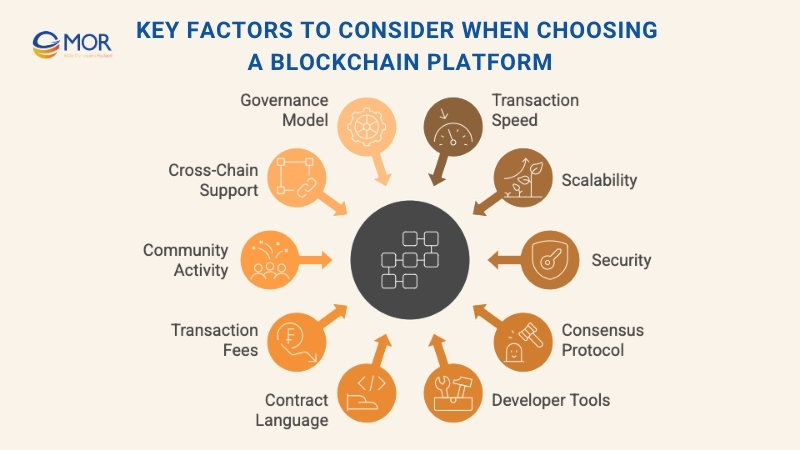
Here are the key things you should look at when comparing options:
Factor | Why It Matters |
| Transaction Speed | Faster platforms can process smart contracts and transfers more quickly, which improves performance and usability. |
| Scalability | A good platform grows with your app, handling more users and higher loads without breaking down. |
| Security | Strong encryption and a resilient network are non-negotiable for protecting assets and user trust. |
| Consensus Protocol | This defines how network decisions are validated, each method (PoS, PoW, BFT) has pros and cons. |
| Developer Tools | Access to SDKs, APIs, and testing frameworks makes it easier to build and launch apps. |
| Contract Language | The programming language used for smart contracts can affect compatibility and ease of development. |
| Transaction Fees | High costs can hurt adoption. A platform with reasonable fees is better for both startups and enterprises. |
| Community Activity | Platforms backed by active developer communities tend to evolve faster and provide better support. |
| Cross-Chain Support | Interoperability with other networks adds flexibility and opens up more use cases. |
| Governance Model | How updates and rules are managed can affect long-term project control and adaptability. |
Choosing the best blockchain platform depends on your technical needs and business priorities. Getting this part right sets the foundation for everything that follows.
MOR Software – Your Trusted Partner for Blockchain Platforms
When it comes to launching secure, scalable, and custom blockchain platforms, you don’t just need developers, you need a partner who understands the tech and your business.
At MOR Software, we’ve helped startups and enterprises build smart contract systems, manage digital assets, and launch decentralized applications that actually work in the real world. From ideation to post-deployment support, we cover every step.
Our team specializes in popular platforms like Ethereum, Hyperledger, and Corda, but we also work with emerging stacks tailored to your industry. Whether you're building a blockchain based eCommerce platform, exploring cross-chain compatibility, or integrating with existing systems. We’ve done it.
Why MOR?
- Proven delivery record across finance, logistics, and healthcare
- Custom smart contract and DApp development services
- Seamless integration with cloud, APIs, and enterprise tools
- Full-cycle support: from planning and prototyping to scaling and support
If you're serious about building with the best blockchain platform for your goals, let’s talk. Your tech deserves more than generic solutions. It needs precision, speed, and a team that builds for outcomes.
Ready to start? Contact us to discuss your project.
Conclusion
Choosing the right blockchain platforms to build smart contracts isn’t about following hype. Each platform in this list has strengths, from speed and scalability to privacy and developer tools. If you’re planning a blockchain project and need a reliable tech partner, MOR Software is here to help. Contact us and let’s build something secure, scalable, and future-ready.
MOR SOFTWARE
Frequently Asked Questions (FAQs)
What is blockchain, and how does it work?
Blockchain is a type of distributed ledger technology that records transactions across a shared network. It’s designed to be tamper-proof, with data verified and stored across multiple nodes instead of a central server.
Why do businesses use blockchain platforms?
Blockchain platforms offer tools for building secure, transparent, and self-running systems. They help automate transactions, reduce reliance on intermediaries, cut costs, and build trust between parties.
Which blockchain platforms were covered in this article?
We explored IBM Blockchain, Tron, Stellar, NEO, Corda, Ethereum, MultiChain, EOS, Hyperledger Fabric, OpenChain, Quorum, and NEM as the top choices for 2025.
What makes these platforms valuable for business?
Each one brings something different to the table, whether it’s scalability, privacy, developer tools, or regulatory features. Together, they support everything from digital identity to project blockchain development.
Why is blockchain becoming so relevant across industries?
From banking to healthcare, more companies are turning to blockchain to streamline operations, safeguard data, and boost transparency. It’s reshaping how we manage digital assets and conduct transactions at scale.
Rate this article
0
over 5.0 based on 0 reviews
Your rating on this news:
Name
*Email
*Write your comment
*Send your comment
1